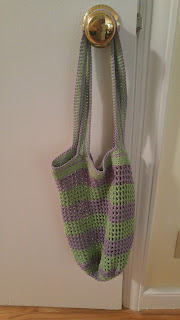30 Fabulous Crochet Flowers & Projects
by Haafner Linssen
Published by Interweave, an imprint of F+W Media, Inc.
Copyright 2018
I have worked with fibers almost all my life. My grandmother
taught me how to crochet and knit when I was 5 years old. Later on, I learned
how to do needlepoint and cross stitch – I think my grandmother taught me those
skills, also. I know she taught me how to use a sewing machine – she had an old
Singer Treadle machine, and that's what I learned on. When I got older, I
learned how to weave on an inkle loom and a rigid heddle loom. And I also wove
on one of those square peg looms to make pot holders. I loved all things fiber
(and I still do)! But I didn't realize I was missing another fun fiber skill –
weaving on the Bloom Loom – until Interweave asked me to review a book – Crochet Loom Blooms, by Haafner Linssen.
When I received the book, I was amazed at all the flowers
you could make on the same bloom loom. And the different crochet edgings you
could use. Or – as the author mentions – you could use the loomed pieces in
your weaving, sewing, macramé, or knitting (and crochet). There are 30 different flower
patterns she creates with the loom and crocheted edgings. So just think of all
that you can do with your loomed pieces. These are just a few of the pieces from the book:
She also has 5 different patterns to
crochet – a potholder to start with, a scarf, a bag, a blanket, and a chunky
throw. Of course, you can use other patterns – pick a pattern with motifs and
substitute one or more motifs that you can make from this book. Or create your own
pattern to use the Crochet Loom Bloom motif(s) that you make.
Even though the book comes with its' own flat loom to try, I
decided to order the Clover Hana-Ami Loom that the author recommends. It's
available on-line. And then I read up on how to use the loom, so I would be
ready to go when it was delivered. A few days later, I got the loom, and put it
together (the instructions about how to do that are in the book, and also come
with the loom). I found the author's instructions about using the Hana-Ami loom
to make the various blooms very thorough. She tells what type of yarn is
the best to use, but also how to modify your loom if you want to use different
weights or yarns. She shows how to put the loom together, how to use different looming
techniques, how to use multiple sizes of the loom in one bloom, how to form different
shapes in the bloom by changing up the loom, how to form different flower bud
centers, how to use embellishments, and all sorts of tips and tricks! The book
even has a chapter on basic crochet techniques, and another chapter on
different joining methods. So all you need is in this book.
I wanted to make my first bloom, and found in my stash some dk weight
yarn to use. That's the weight yarn that the author uses for the blooms in
the book. But, she also shows how to substitute other weights. And how to vary
the crocheted edging, if you want to use it. And how to vary the center of the bloom. I decided that I
was just going to make a thick bloom, with a thick center, with no crocheted edging. The second bloom I made was out of Ribbon yarn, also in my stash. I made it thick, also, but it didn't have to have as many rotations around the loom as my first bloom, because this yarn was thicker than the first yarn I used. The picture of both of them is below. I really like both of them. Now all I have to do is tie off the ends and attach a pin, and I'll have 2 flower pins I can wear on a sweater, or put on one of my crocheted totes or basket or use as a charm on a necklace. I
have lots of ideas for them. (The first bloom I made is on the bottom - the second one I made is on the top.)
Here are more of the blooms and projects from the book.
And here's an adorable picture. (The afghan is cute, too!)
One more thing that I discovered - if you have leftovers from other yarn projects - you know, those leftovers where the amount of yarn left over is not enough to crochet or knit with, but too much to just throw away - you can always use it on the Bloom Loom.
And - I almost forgot - the flowers and the patterns in the book have great written directions, AND stitch diagrams for the flowers and the patterns, both! So you're covered, whether you like to work from written directions or diagrams!
And - I almost forgot - the flowers and the patterns in the book have great written directions, AND stitch diagrams for the flowers and the patterns, both! So you're covered, whether you like to work from written directions or diagrams!
If you want to order a Bloom Loom like the author recommends
and used, and like I used, you can order the book and the loom as a set, from
Interweave:
(All the pictures in this post, except for the picture of the two blooms that I made, are from F+W Media.)
































































